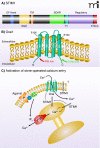Pharmacology of store-operated calcium channels
- PMID: 20729487
- PMCID: PMC2965610
- DOI: 10.1124/mi.10.4.4
Pharmacology of store-operated calcium channels
Abstract
Store-operated calcium entry is a process by which the depletion of calcium from the endoplasmic reticulum activates calcium influx across the plasma membrane. In the past few years, the major players in this pathway have been identified. STIM1 and STIM2 function as calcium sensors in the endoplasmic reticulum and can interact with and activate plasma membrane channels comprised of Orai1, Orai2, or Orai3 subunits. This review discusses recent advances in our understanding of this widespread signaling mechanism as well as the mechanisms by which a number of interesting pharmacological agents modify it.
Figures




Similar articles
-
A novel native store-operated calcium channel encoded by Orai3: selective requirement of Orai3 versus Orai1 in estrogen receptor-positive versus estrogen receptor-negative breast cancer cells.J Biol Chem. 2010 Jun 18;285(25):19173-83. doi: 10.1074/jbc.M110.102582. Epub 2010 Apr 15. J Biol Chem. 2010. PMID: 20395295 Free PMC article.
-
STIM2 drives Ca2+ oscillations through store-operated Ca2+ entry caused by mild store depletion.J Physiol. 2013 Mar 15;591(6):1433-45. doi: 10.1113/jphysiol.2012.245399. Epub 2013 Jan 28. J Physiol. 2013. PMID: 23359669 Free PMC article.
-
Large store-operated calcium selective currents due to co-expression of Orai1 or Orai2 with the intracellular calcium sensor, Stim1.J Biol Chem. 2006 Aug 25;281(34):24979-90. doi: 10.1074/jbc.M604589200. Epub 2006 Jun 28. J Biol Chem. 2006. PMID: 16807233 Free PMC article.
-
Molecular physiology and pathophysiology of stromal interaction molecules.Exp Biol Med (Maywood). 2018 Mar;243(5):451-472. doi: 10.1177/1535370218754524. Epub 2018 Jan 24. Exp Biol Med (Maywood). 2018. PMID: 29363328 Free PMC article. Review.
-
Stromal interaction molecules as important therapeutic targets in diseases with dysregulated calcium flux.Biochim Biophys Acta. 2014 Oct;1843(10):2307-14. doi: 10.1016/j.bbamcr.2014.03.019. Epub 2014 Mar 25. Biochim Biophys Acta. 2014. PMID: 24681268 Review.
Cited by
-
STIM1 Knockout Enhances PDGF-Mediated Ca2+ Signaling through Upregulation of the PDGFR⁻PLCγ⁻STIM2 Cascade.Int J Mol Sci. 2018 Jun 18;19(6):1799. doi: 10.3390/ijms19061799. Int J Mol Sci. 2018. PMID: 29912163 Free PMC article.
-
Calcium influx enhances neuropeptide activation of ecdysteroid hormone production by mosquito ovaries.Insect Biochem Mol Biol. 2016 Mar;70:160-9. doi: 10.1016/j.ibmb.2016.01.001. Epub 2016 Jan 7. Insect Biochem Mol Biol. 2016. PMID: 26772671 Free PMC article.
-
Store-Operated Calcium Entry in Skeletal Muscle: What Makes It Different?Cells. 2021 Sep 8;10(9):2356. doi: 10.3390/cells10092356. Cells. 2021. PMID: 34572005 Free PMC article. Review.
-
Honokiol blocks store operated calcium entry in CHO cells expressing the M3 muscarinic receptor: honokiol and muscarinic signaling.J Biomed Sci. 2013 Feb 23;20(1):11. doi: 10.1186/1423-0127-20-11. J Biomed Sci. 2013. PMID: 23432810 Free PMC article.
-
Constitutive activation of the calcium sensor STIM1 causes tubular-aggregate myopathy.Am J Hum Genet. 2013 Feb 7;92(2):271-8. doi: 10.1016/j.ajhg.2012.12.007. Epub 2013 Jan 17. Am J Hum Genet. 2013. PMID: 23332920 Free PMC article.
References
-
- Parekh AB, Putney JW. (2005) Store-operated calcium channels. Physiol Rev 85:57–810 - PubMed
-
- Putney JW. (1986) A model for receptor-regulated calcium entry. Cell Calcium 7:1–12 This hypothesis paper first described a model whereby depletion of endoplasmic calcium stores activated calcium permeable channels in the plasma membrane. - PubMed
-
- Putney JW. (2001) Pharmacology of capacitative calcium entry. Mol Interv 1:84–94 - PubMed
-
- Tsien RY. (1989) Fluorescent probes of cell signalling. Ann Rev Neurosci 12:227–253 - PubMed
Publication types
MeSH terms
Substances
Grants and funding
LinkOut - more resources
Full Text Sources
Other Literature Sources
Miscellaneous
